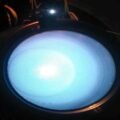Chinese scientists have created a gravity manipulation chamber that simulates low gravity environments like those found on the moon. Inspired by previous research that involved levitating a frog, the “artificial moon” is expected to help the Chinese National Space Agency (CNSA) to prepare for future missions to Earth’s lone natural satellite.
BAKCGROUND: FLOATING FROGS AND THE IG-NOBLE PRIZE
In the year 2000, University of Manchester physicist Andre Geim won the tongue-in-cheek “Ig Noble Prize” for his experiment that involved using magnetic fields to float a frog. Now, Chinese researchers have taken the nuts-and-bolts physics of that previous work and are applying it to their artificial moon.
ANALYSIS: ARTIFICIAL MOON SIMULATES LOW GRAVITY ENVIRONMENTS
In a story by the South China Morning Post, geotechnical engineer at the China University of Mining and Technology Li Ruilin, who is a member of the team building the artificial moon, said that their gravity chamber uses powerful magnetic fields inside a 2-foot diameter vacuum chamber to reduce the pull of gravity, making it the “the first of its kind in the world.” To accomplish this feat, the chamber uses a property known as diamagnetic levitation.
According to a piece by Live Science, “Atoms are made up of atomic nuclei and tiny electrons that orbit them in little loops of current; these moving currents, in turn, induce tiny magnetic fields. Usually, the randomly oriented magnetic fields of all the atoms in an object, whether they belong to a drop of water or a frog, cancel out, and no material-wide magnetism manifests.”
However, as Geim proved back in 2000, if one applies a magnetic field to those atoms, the electrons will actually produce their own opposing magnetic field in response. Furthermore, if that applied external field is powerful enough, that opposing force will result in a reduction of gravity all the way down to zero G.
Voila! Floating frog.
According to Li, the chamber being built on this technology will allow researchers to test components in a limited gravity environment like the 1/6th environment found on the moon to work out the kinks before those components are actually sent there. And, he says, the chamber can simulate these low gravity environments “for as long as you want.”
“Some experiments, such as an impact test, need just a few seconds [in the simulator],” said Li. “But others, such as creep testing (where material undergoes a long, constant stress), can take several days.”
OUTLOOK: GRAVITY MANIUPULATION WILL AID FUTURE LUNAR MISSIONS
The CSNA has already sent recent missions to the moon under the Chang’e mission banner. Chang’e-4 landed a rover on the dark side of the moon back in 2019, and the Chang’e-5 mission scooped up some lunar material in 2020 and returned it to Earth for closer study.
Finally, according to the Morning Post report, the gravity simulator “is expected to be launched in the coming months,” and will be a critical tool in preparing for China’s future Chang’e lunar missions.
Follow and connect with author Christopher Plain on Twitter: @plain_fiction
